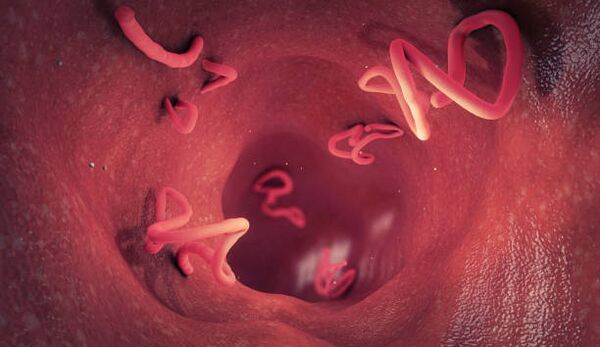Worms are worms that carry on a parasitic lifestyle in the body of their host, a person. Age does not matter. Both adults and children are susceptible to infections. The classification of helminthiasis is very extensive, especially in countries with hot climates.

Parasitic worms have 3 classes:
- round (nematodes) - pinworms, roundworms;
- tapeworm (cestodes) - porcine tapeworm, bovine tapeworm, echinococcus;
- flatworms, trematodes.
The most common worms in children are pinworms, which cause enterobiasis. These helminth patterns are small, averaging no more than 1 cm, white-gray in color, and curved in body. These parasites are localized in the colon, but can also penetrate the lower parts of the small intestine. Pinworms multiply on the skin near the anus. At night, female pinworms come out to lay eggs in the folds of the skin, often penetrating the labia of girls, ending in infectious diseases of the genitals. In total, these helminths live for about 1-1, 5 months. The process of self-infection of a child can lead to malaise continuing for many years. Parasites can be detected in the feces with the naked eye.
Roundworms are another type of worms that are most common in children. In a typical species, 15 cm long, these nematodes settle in the lumen of the small intestinal loops, moving towards the moving food node. Roundworms very rarely get into the stool. Females periodically release oocytes, which are found during fecal analysis. But if they were not found during the test, that does not mean that the child was not infected. The life cycle of a roundworm can last for several years.
The reasons
The baby’s curiosity is realized by his fingers, the child, by getting to know the world, actively touches everything that gets under his arm and immediately pulls it into his mouth, seeking strength and taste. Thus, pinworm eggs enter the digestive system of their prospective little owner safely.
The child becomes infected with worm eggs from the surface of the unwashed fruit when he drinks contaminated water. Very often, infection occurs when communicating with animals or when playing in the ground, in a sandpit, where cats and dogs like to solve their physiological problems. After walking, children often do not wash their hands and all the dirt as well as parasitic eggs get into their mouths.
Symptoms
If a child is infected with the eggs of a large number of parasitic worms, a sharp deterioration can occur in a few days. In milder cases, the first symptoms of invasion appear after several weeks or even months. Much depends on the child's immunity. It can cope well with parasites and restrain their development. But the defense gradually decreases and the helminths infect the body, causing serious problems.
The first signs are symptoms of poisoning (poisoning). The vital activity of worms involves the release of a large number of animal toxins that can poison a child’s body. In the intestines, parasitic worms use nutrients, as a result of which the baby gradually suffers from a lack of protein, carbohydrates, fats and vitamins.
The child:
- emaciation,
- pallor of the skin,
- weakness, frequent dizziness,
- fever, headache,
- bad dream,
- tears,
- depressed mood.
Intestinal diseases are manifested - constipation, loose stools, growl and abdominal pain, nausea and vomiting, painful sensations in different parts of the abdomen and bloating. The disease can be associated with allergic conditions: itching, rash, cough, inflammation of the mucous membranes of the airways. Weakened immunity leads to the addition of infectious diseases.
Diagnosis and treatment
Diagnosing helminthiasis in the stool is quite difficult. This is due to the fact that wormwood oocytes or pinworms do not appear in the wormwood on a daily basis, and the smear microscopic technique from the analysis requires great care. To increase the reliability of worm egg fecal analysis, at least 3 consecutive days are recommended.
In the event of an increased risk of infection by worms (contact with animals, children's play on the ground or in the open sandbox, the child's habit of taking things in his mouth, biting his nails or licking his fingers, etc. ), it is advisable toin addition to triple analysis of feces, it performs special tests on the blood to detect antibodies to helminth.
Allergic manifestations of unknown origin, increase in eosinophils in the blood test, persistent intestinal dysbiosis in the presence of persistent intestinal dysbiosis are advisable to donate blood for the determination of class E immunoglobulins (Ig E and G) for globular worms and other helminth samples. You can check for the presence of worms in pets.
When assessing the totality of indirect symptoms and a history, the physician may recommend anthelmintic therapy without direct evidence of the presence of worms in the child, to the exclusion of other pathologies causing similar clinical symptoms. the focus of infection with each other in helminth samples. In this situation, in addition, hygiene measures need to be strengthened, especially the boiling and ironing of bedding and personal bedding on both sides.
























